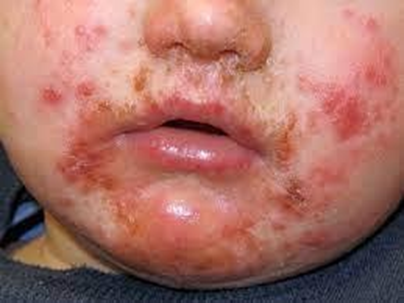A nurse is providing teaching to the parents of a child who has impetigo. Which of the following instructions should the nurse include in the teaching?
Apply bactericidal ointment to lesions.
Administer acyclovir PO two times per day.
Soak hairbrushes in boiling water for 10 min.
Seal soft toys in a plastic bag for 14 days.
The Correct Answer is A
Rationale:
A. Applying bactericidal ointment to lesions helps treat impetigo by killing the bacteria causing the infection.

B. Acyclovir is used to treat viral infections such as herpes simplex virus, not bacterial infections like impetigo.
C. Soaking hairbrushes in boiling water is not necessary for treating impetigo.
D. Soft toys do not need to be sealed in a plastic bag for treating impetigo.
Nursing Test Bank
Naxlex Comprehensive Predictor Exams
Related Questions
Correct Answer is B
Explanation
Rationale:
A. Washing the child's hair with ketoconazole shampoo is not typically indicated for treating scabies, which is caused by mites.
B. Treating close contacts is essential to prevent the spread of scabies.
C. Applying petroleum jelly is not an effective treatment for scabies.
D. Soaking combs and brushes in boiling water may help to disinfect them but is not the primary treatment for scabies.
Correct Answer is D
Explanation
A. Rhinorrhea (runny nose) is a common symptom of respiratory syncytial virus (RSV) and may not require immediate reporting unless severe or accompanied by other concerning symptoms.
B. Pharyngitis (sore throat) is not typically considered a critical finding in RSV infection.
C. Coughing is a common symptom of RSV and is expected in infants with the infection. While coughing may require monitoring, it is not typically an immediate cause for concern unless severe.
D. Tachypnea (rapid breathing) is a concerning finding in infants with RSV infection, especially if it is severe or accompanied by signs of respiratory distress. Severe tachypnea may indicate worsening respiratory compromise and requires immediate attention and reporting to the healthcare provider for further evaluation and management.
Whether you are a student looking to ace your exams or a practicing nurse seeking to enhance your expertise , our nursing education contents will empower you with the confidence and competence to make a difference in the lives of patients and become a respected leader in the healthcare field.
Visit Naxlex, invest in your future and unlock endless possibilities with our unparalleled nursing education contents today
Report Wrong Answer on the Current Question
Do you disagree with the answer? If yes, what is your expected answer? Explain.
Kindly be descriptive with the issue you are facing.
